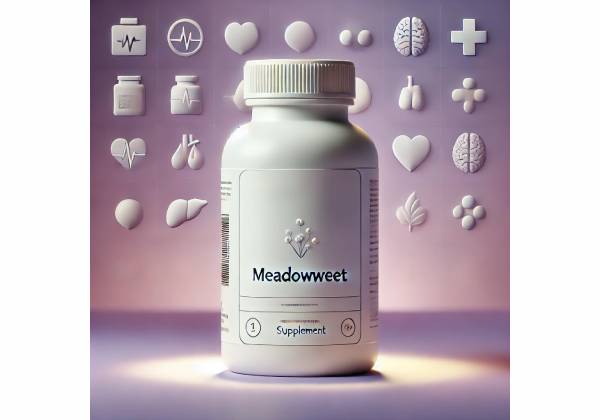
Meadowsweet (Filipendula ulmaria) is a fragrant wildflower long valued in European herbal traditions. The plant’s creamy blossoms and tender aerial parts contain a blend of salicylates, flavonoids, and tannins that together offer gentle support for aches, minor fevers, and digestion. Unlike aspirin, meadowsweet does not contain acetylsalicylic acid; its naturally occurring salicylates are part of a broader phytochemical matrix that many people find easier on the stomach when used appropriately. Today, meadowsweet shows promise as a mild anti-inflammatory and antioxidant, often used in teas or liquid extracts during colds, after big meals, or alongside rest to take the edge off minor joint and muscle discomfort. Because evidence in humans is still limited, it’s best approached as supportive care, not a stand-alone treatment. This guide distills what the plant is, how it works, where it seems to help, and how to use it safely—so you can decide whether it belongs in your cupboard and exactly how to dose it with confidence.
Key Insights
- May ease minor aches and support cold symptoms; tea is the classic form.
- Can calm sour stomach and occasional heartburn when used short term.
- Typical adult tea: 1.5–6 g dried herb per cup, up to 2–18 g per day.
- Avoid if you have salicylate/aspirin allergy, active ulcers, or take blood thinners.
- Not recommended for children or adolescents; avoid in pregnancy and while nursing.
Table of Contents
- What is meadowsweet and how it works
- Proven and probable benefits
- How to choose and use forms
- How much to take and when
- Side effects, interactions, and who should avoid
- What the science says so far
What is meadowsweet and how it works
Meadowsweet (Filipendula ulmaria) is a perennial in the rose family that thrives in cool, damp meadows, hedgerows, and river margins. Herbal medicine uses the aerial parts—typically the flowering tops—harvested during bloom when the plant’s scent and oil content are highest. Traditional European texts describe meadowsweet as a “cooling” herb for fevers, aches, and digestive upsets. Modern analyses reveal a complex chemistry that helps explain those uses.
The key constituents include:
- Salicylates (e.g., salicylaldehyde derivatives and methyl salicylate in the essential oil). These aromatic compounds are metabolized into salicylic acid in the body, contributing to mild pain-relief, fever-reduction, and anti-inflammatory effects.
- Flavonoids (such as quercetin glycosides like spiraeoside). Flavonoids modulate inflammatory pathways and provide antioxidant activity that can stabilize cell membranes and scavenge free radicals.
- Hydrolysable tannins (notably ellagitannins like tellimagrandin). Tannins have an astringent, tissue-toning effect, which may help tighten and protect irritated mucous membranes in the stomach and throat.
- Phenolic acids and volatile oils. These contribute to aroma, digestive support, and additional antioxidant benefits.
Mechanistically, the herb appears to down-shift inflammatory signaling through multiple routes: tempering cyclooxygenase activity (a pathway involved in prostaglandin synthesis), buffering oxidative stress, and providing a gentle astringent action that can soothe the gut lining. A nuanced point many users appreciate: meadowsweet is not aspirin. Aspirin is acetylated and acts as an irreversible COX inhibitor, which partly explains its stronger antiplatelet effects and gastric side-effect profile. Meadowsweet’s salicylates are part of a whole-plant matrix with tannins and flavonoids that may soften the stomach impact for some people, especially when prepared as a tea. That said, salicylate sensitivity and drug interactions remain relevant, and the plant should be used sensibly.
From a practical standpoint, meadowsweet is a supportive herb suited to self-care scenarios—like easing a tension-type headache after a long workday, taking the sting out of seasonal sniffles, or calming a sour stomach after a heavy meal—rather than treating serious conditions. You’ll find it in loose teas, tea bags, tinctures, and capsules, with tea and tincture favored for flexible dosing and quick onset.
Proven and probable benefits
Herbal traditions often get out over their skis, so it’s worth separating well-grounded benefits from early signals. For meadowsweet, human clinical trials remain limited, but regulatory monographs and modern lab studies converge on a few realistic uses:
1) Supportive care in common colds.
Meadowsweet tea has long been taken at the first sign of a cold, particularly when low-grade fever, sore throat, or achy joints accompany the illness. The herb’s salicylate content may help with discomfort, while mild diaphoretic effects (promoting a light sweat) align with traditional “cooling” use. In practice, people combine meadowsweet with elderflower or linden for symptom relief, drinking warm cups several times per day for a few days.
2) Relief of minor musculoskeletal pain.
Meadowsweet’s gentle anti-inflammatory and analgesic actions make it a plausible add-on for day-to-day aches—think stiffness after gardening, mild tension headaches, or discomfort after a long hike. It is not fast or forceful like an over-the-counter NSAID; rather, it takes the edge off when used regularly over several days. Users who prefer tea often describe a “softening” of pain alongside a sense of overall ease.
3) Soothing an upset stomach.
The tannins in meadowsweet are astringent and can help tighten irritated tissue, while the flavonoids and salicylates provide calming, anti-inflammatory support. Taken 15–30 minutes before meals, a warm cup may reduce occasional heartburn or sour stomach related to overeating. Short-term use is typical; persistent or severe symptoms warrant medical evaluation.
4) Antioxidant support.
In vitro and animal data show notable antioxidant effects from meadowsweet extracts, which may help the body buffer oxidative stress. While that doesn’t automatically translate into clinical outcomes, it provides a mechanistic rationale for the traditional “tonic” use during convalescence or high-stress periods.
What the evidence does not show clearly (yet):
- Strong human RCTs confirming efficacy for arthritis, peptic ulcers, or chronic inflammatory diseases are sparse.
- Long-term safety data in specific populations (pregnancy, lactation, children, people on multiple medications) are insufficient; authoritative bodies advise against use in these groups.
Practical expectations:
- For colds and minor aches, benefits are subtle and cumulative over 24–72 hours with repeated cups or doses.
- For digestive comfort, effects may be noticeable within a few doses, especially if triggers (spicy or heavy foods, alcohol) are reduced.
To maximize results, treat meadowsweet as part of a stack: rest, fluids, simple foods, and—when appropriate—evidence-based medicines recommended by your clinician. If symptoms escalate, don’t self-treat—seek care.
How to choose and use forms
Meadowsweet comes in several preparations. Choosing the right one depends on your goals, taste, and how precisely you want to dose.
Tea (infusion of the comminuted herb)
- Best for: colds, mild fevers, everyday aches, and general antioxidant support.
- Pros: soothing ritual, rapid absorption, adjustable strength.
- Cons: variable potency between batches; requires preparation time.
- Shopping tips: look for cut & sifted flowering tops harvested early to mid-bloom, stored in opaque packaging. Color should be greenish-gold, with a sweet, almond-like aroma.
Tincture (1:5 in ~45% ethanol)
- Best for: those who prefer liquid dosing with reliable concentration, quick onset, and portability.
- Pros: predictable dosing; easy to combine with other tinctures (e.g., elderflower for colds or ginger for digestion).
- Cons: contains alcohol; taste can be bittersweet and aromatic.
- Usage note: dilute each dose in a small amount of water to soften the flavor.
Powdered herb and capsules
- Best for: convenience and travel.
- Pros: measured doses with no preparation.
- Cons: fewer sensory cues (aroma/taste), which can make it easier to overuse; slower onset compared to tea or tincture.
- Quality cues: request a lot-specific certificate of analysis where possible. Fresh material should retain a pleasant scent; stale powder often smells dull or musty.
Combination formulas
Meadowsweet pairs well with elderflower or linden for colds; ginger or chamomile for digestion; and turmeric or devil’s claw for aches (if appropriate). Combinations can be helpful, but they also complicate safety if you take medications—check for interactions.
Storage and shelf life
- Tea herb: tightly sealed container, away from light and moisture; use within 12 months for best aroma and effect.
- Tincture: stable for 3–5 years if sealed and stored cool.
- Capsules/powder: check expiry; store airtight to preserve volatile oils.
When to use
- Colds: at the first tingle of a sore throat, start warm tea and repeat every few hours the first day.
- Aches: steady twice-daily use for several days tends to work better than one large dose.
- Digestion: take a small cup before meals likely to trigger indigestion.
Remember, quality matters. Seasonal and habitat factors can shift the plant’s salicylate profile—early blooming tops often carry a more pronounced aroma and robust essential oil yield—so buy from suppliers who harvest at the correct stage and test their lots.
How much to take and when
Authoritative European guidance provides practical ranges for adults. The following dosing guidance refers to dried herb (aerial parts) unless noted and is intended for short-term use in minor, self-limiting conditions. Always follow the product label, and consult a clinician if you take medications or have medical conditions.
Adults (including older adults)
- Tea (infusion of comminuted herb):
- Single dose: 1.5–6 g (roughly 1–4 teaspoons depending on cut), steeped in 150–250 ml hot water for 10–15 minutes.
- Daily total: 2–18 g divided into 2–4 cups.
- Powdered herb (capsules or loose):
- Single dose: 250–500 mg.
- Daily total: 250–1,500 mg in divided doses.
- Tincture (1:5, ~45% ethanol):
- Single dose: 2–4 ml in water.
- Daily total: 6–12 ml, split 2–3 times per day.
Timing tips
- For colds and aches, begin at first symptoms. A cup every 3–4 hours on day one, then 2–3 times daily for another 2–3 days, is a common pattern.
- For digestive comfort, take a cup 15–30 minutes before meals or immediately after a heavy meal if you forgot to pre-dose.
Duration of use
- For colds: start early; if symptoms persist beyond 7 days, worsen, or exceed 39°C fever, seek medical advice.
- For minor joint pains: avoid using continuously for more than 4 weeks without clinician guidance.
Hydration and meals
- Tea naturally adds fluids, which helps during fevers.
- If your stomach is sensitive, take tincture doses diluted in water or with a small snack.
Special populations
- Children and adolescents: use is not recommended due to lack of adequate safety data.
- Pregnancy and lactation: not recommended because safety has not been established.
- Older adults with multiple medications: consult a clinician before use, especially if you take anticoagulants, other NSAIDs, or have a history of ulcers.
Signs you may need to adjust or stop
- New or worsening stomach pain, nausea, heartburn, bruising, or ringing in the ears.
- Any allergic signs (rash, wheeze, swelling) require immediate discontinuation and medical attention.
Used thoughtfully within these ranges, meadowsweet is generally well tolerated for short periods and can be a practical addition to a conservative self-care plan.
Side effects, interactions, and who should avoid
Although many people tolerate meadowsweet well, its salicylate content means the usual cautions apply. Respect these boundaries to keep risk low.
Common, typically mild issues
- Stomach upset or heartburn: more likely at higher doses or on an empty stomach. Reduce the dose, switch to tea (which includes tannins that some find gentler), or take with a light snack.
- Nausea or headache at high intake: step back to the lower end of the range.
- Allergic reactions: rare but possible—especially if you have a known salicylate/aspirin allergy or asthma sensitive to NSAIDs.
Less common but important
- Bleeding risk: salicylates can add to the effects of anticoagulants (e.g., warfarin), antiplatelets (e.g., clopidogrel), and other NSAIDs. Combining them raises bleeding and stomach-irritation risk. If you take these medicines, check with your clinician before using meadowsweet—or avoid it.
- Ulcer history or active gastritis: meadowsweet may aggravate symptoms in some people despite its tannins. Avoid unless a clinician specifically approves.
- Tinnitus (ringing in the ears): a classic sign of salicylate excess—stop and seek guidance.
Who should not use meadowsweet
- Anyone with salicylate/aspirin allergy or aspirin-sensitive asthma.
- People with active peptic ulcer disease, bleeding disorders, or those on warfarin, other anticoagulants, or regular NSAIDs unless a clinician approves and monitors.
- Children and adolescents (lack of safety data for the herb; salicylate-containing products are generally avoided in under-16s due to the risk of Reye’s syndrome with viral illness).
- Pregnancy and breastfeeding: not recommended; safety data are insufficient.
Interactions at a glance
- Additive with other NSAIDs or aspirin: increases GI and bleeding risk.
- Potential additive antiplatelet effect: caution with antiplatelet regimens.
- Alcohol: high alcohol intake compounds GI irritation; keep doses modest and separate from drinking.
When to seek medical help
- Fever above 39°C, shortness of breath, chest pain, or severe headache.
- Black or tarry stools, vomiting blood, or persistent abdominal pain.
- Any allergic signs (wheezing, facial swelling, widespread hives).
Bottom line: meadowsweet is supportive, not curative. Use it short-term, at conservative doses, and stay alert to the red flags above.
What the science says so far
The modern evidence base for meadowsweet is modest but growing. Here’s how it currently stacks up:
Regulatory and traditional frameworks
European authorities recognize meadowsweet as a traditional herbal medicinal product for the supportive treatment of common cold and the relief of minor articular pain. Official monographs also specify adult dosing ranges for tea, tincture, and powdered herb, and they caution against use in children and adolescents as well as in pregnancy and lactation due to insufficient safety data. These documents do not claim disease-modifying effects but affirm a reasonable safety profile when used as directed.
Phytochemistry and mechanisms
Analytical studies show that meadowsweet’s chemical profile varies with growth stage and habitat, with early blooming inflorescences often yielding higher essential oil content. The oils and polyphenols—flavonoids and ellagitannins—work together to provide antioxidant and anti-inflammatory actions. Laboratory models suggest modulation of eicosanoid pathways and down-regulation of oxidative damage, consistent with the plant’s traditional uses.
Preclinical efficacy
Cell and animal studies report analgesic, anti-inflammatory, gastroprotective, and antioxidant effects from aqueous and hydroalcoholic extracts. These data bolster the plausibility of symptomatic relief in humans and support the herb’s use for short-term, mild conditions. However, animal dosing is not directly interchangeable with human tea or tincture dosing.
Human evidence
Direct randomized controlled trials in humans are limited. Observational experience and longstanding traditional use inform most modern practice. This is why dosing guidance emphasizes short duration, symptom-focused use, and prompt medical evaluation if symptoms persist or worsen.
Safety synthesis
Across regulatory reviews and pharmacovigilance summaries, serious adverse events with meadowsweet are rare when used at recommended doses for limited periods. The main risks mirror salicylate pharmacology: GI irritation, bleeding risk with anticoagulants/antiplatelets, and reactions in people with salicylate allergy. Because robust safety data are lacking in certain groups, conservative “do not use” guidance applies to children/adolescents, pregnancy, and breastfeeding.
Research gaps and what to watch
- Standardized extracts: Trials using chemically characterized extracts could clarify dose-response and safety.
- Head-to-head comparisons: Studies versus low-dose OTC analgesics for tension headaches or viral upper respiratory symptoms would be especially informative.
- Biomarkers: Linking symptom changes with inflammatory and oxidative biomarkers could help pinpoint responders.
Practical takeaway: The current evidence supports meadowsweet as a well-tolerated adjunct for minor aches, colds, and occasional digestive discomfort—used briefly and within established adult dosing. It is not a substitute for medical care in serious or persistent conditions.
References
- Assessment report on Filipendula ulmaria (L.) Maxim., herba and Filipendula ulmaria (L.) Maxim., flos 2011 (Guideline)
- Variations in Yield, Essential Oil, and Salicylates of Filipendula ulmaria Inflorescences at Different Blooming Stages 2023
- DNA-Protective, Antioxidant and Anti-Carcinogenic Potential of Meadowsweet (Filipendula ulmaria) Dry Tincture 2024
- Antioxidant, anti-inflammatory and gastroprotective activity of Filipendula ulmaria (L.) Maxim. and Filipendula vulgaris Moench 2018
- Who can and cannot take aspirin for pain relief 2021 (Guideline)
Medical Disclaimer
This information is educational and does not replace personalized medical advice, diagnosis, or treatment. Herbs can interact with medicines and may not be appropriate for everyone. Always consult a qualified healthcare professional before starting, stopping, or combining meadowsweet with any medication, during pregnancy or breastfeeding, or for use in children and adolescents. If symptoms are severe, unusual, or persist beyond a few days, seek medical care.
If you found this guide useful, consider sharing it with a friend or on Facebook, X (formerly Twitter), or any platform you prefer. Your support helps us keep creating clear, trustworthy health content. Thank you.










